MXA’S 2015 HUSQVARNA FC450 MOTOCROSS TEST: IS WHITE RIGHT?
Q: FIRST AND FOREMOST, IS THE 2015 HUSQVARNA FC450 BETTER THAN THE 2014 FC450?
A: Yes. Husqvarna made major changes to the FC450 that improved it over last year’s model.
Q: WHAT DID HUSQVARNA CHANGE FOR 2015?
A: Guess what? Almost every change that KTM made to the 2015 450SXF, Husqvarna made to the FC450. The biggest changes are to the fork, shock linkage, axles, swingarm and rear suspension.
(1) Swingarm and axle. Last year the Husky FC450 came with KTM’s old-school 20mm rear axle and the swingarm that came with it back in 2011. For 2015, the FC450 gets the new swingarm and the 25mm axle off the current crop of KTMs. Not every 2015 Husky gets the big axle.
(2) 4CS forks. Gone are the WP bladder forks of last year, and in their place are the new 4CS forks. 4CS stand for “Four Chamber System.” The new fork is 6.5 ounces lighter than the old fork. The fork guards are now an open design and do not wrap around like previous Husqvarna fork guards (the old-style fork guards will not fit on the 4CS forks). Unlike on the KTM, there are no in-mold graphics on the fork guards.
(3) Fork offset. The front-axle offset has been changed at the fork lugs by moving the axle 2mm rearward (from 35mm in front of the fork center line to 33mm in front). This change required a switch from last year’s 26mm front axle to a smaller 22mm axle (saving 40 grams) to fit in the reduced space of the axle lug.
(4) Rear suspension. The rising rate has been changed via an all-new bell crank and 2.5mm-longer pull rod. The rising-rate curve is stiffer initially and then flattens out to provide a less progressive curve at the end of the stroke. To accommodate the longer linkage, the WP shock is 4mm longer. The suspension travel remains the same, but the seat height is lowered by 5mm at the rear fender.
(5) Subframe. The lightweight polyamide subframe of the FC450 has been reinforced with an additional screw on the left side that improves fitment and the airbox seal. Also the new subframe has been redesigned to have vent holes in it to help the engine breathe and is 5mm lower than in 2014. Not every 2015 Husky gets this subframe update.
(6) Handlebars. Renthal FatBars have been replaced by Neken bars, but the bend is identical to last year’s. The plastic hand guards have been stiffened up. Neken makes the triple clamps for KTM and Husqvarna. The triple clamps are unchanged for 2015, but they get a new O-ring support for the bottom steering-stem bearing, and the steering-stem bolt is now 17mm instead of 27mm.
(7) Seat cover. The seat-cover material is completely new and completely bad.
(8) Frame cross tube. The cross tube that the shock linkage mounts to has been changed from a tube with welded-on brackets to a one-piece-forged cross tube for more rigidity.
(9) Oil pump O-rings. The oil-pump suction screen gets new O-rings to help it seal better against impurities.
(10) Tires. Every 2015 Husqvarna will be equipped with Dunlop Geomax MX52 tires front and rear.
Q: WHAT PARTS ARE HUSQVARNA ONLY?
A: The proprietary Husqvarna parts are: (1) The polyamide subframe. (2) The molded plastic parts, including the fenders, gas tank, hand guards and side panels. (3) The seat cover. (4) The D.I.D DirtStar rims (as opposed to the Excel rims on the KTM). (5) Two-position map switch on the handlebars.
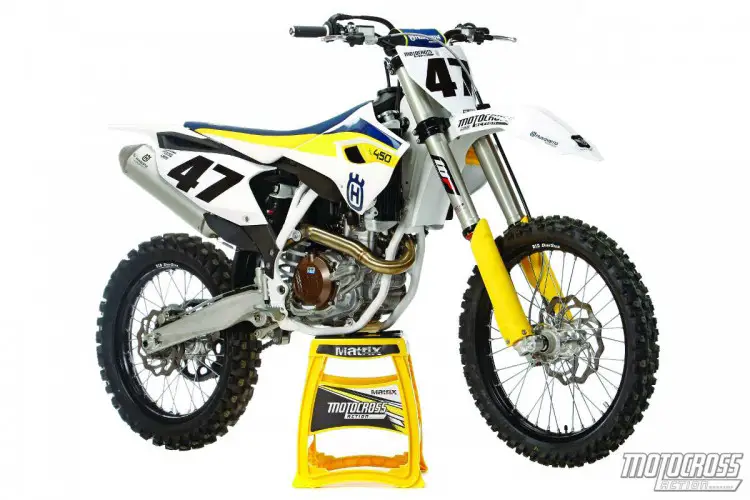
Q: ARE THE 4CS FORKS BETTER THAN LAST YEAR’S WP BLADDER FORKS?
A: Yes, but WP shouldn’t be bragging. The previous bladder fork was light on mid-speed compression and rebound damping, felt harsh in the mid-stroke, and delivered a buckboard-style ride quality. The new 4CS forks are not the best forks on the track (that honor goes to Yamaha’s SSS forks), but compared to last year’s WP forks, the 4CS forks are a step in the right direction. They are a little too firm for the average rider, but any suspension shop should be able to iron that out.
Q: HOW DOES THE 2015 HUSQVARNA FC450 HANDLE?
A: The obvious answer would be, “Like a KTM 450SXF.” But, that gives short shrift to the Husqvarna. Why? Because for some unknown reason, MXA test riders prefer the way the Husqvarna feels in motion over its fraternal twin. We attribute this sensation to the more resilient subframe and the muffled feel of the powerband from low to mid. The combination of more give in the chassis and less loading on the drivetrain gives the Husky more pleasant ride characteristics. But, from a numbers point of view, the KTM 450SXF and Husqvarna FC450 roll down the same assembly line and share identical geometry, wheelbase, weight bias and components. Overall, the Husqvarna is a very good-handling bike, with the caveat that you have to set the front/rear balance up properly. Just like its orange brethren, the Husky requires very little input to get it to do what you want. It rails corners with nary a hint of oversteer or understeer.
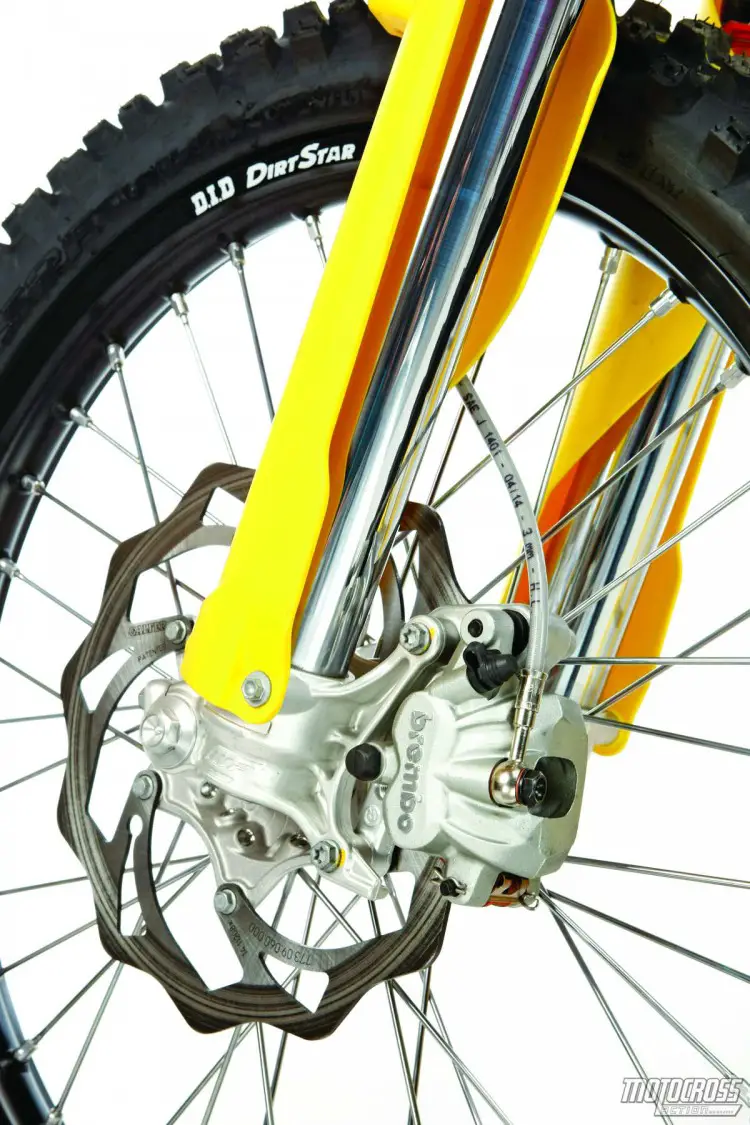
Q: IS THE HUSKY FC450 FASTER THAN THE KTM 450SXF?
A: Given that there is not one iota of difference between the mechanical parts in the two engines and that they make the same peak horsepower, you might be surprised to discover that the FC450 is slower than the 450SXF. How can that be? Well, peak horsepower is measured when the engine is at full song. And, when the Husqvarna FC450 is running wide open, it produces solid horsepower. The problem isn’t at peak; the problem is below peak. Compared to the KTM 450SXF powerband, the Husky feels choked up. It is definitely slower on throttle response than it should be. This is where Sherlock Holmes was called in to crack the case.
If they are identical engines, where did the low-to-mid transition go? Elementary, my dear Watson. It didn’t go anywhere; it is just gasping for air. Husky’s innovative plastic subframe and full-length side panels are choking the engine to death.
Unlike a KTM, which has vents on both sides of the airbox, the Husqvarna airbox is sealed up tighter than the drum that Jimmy Hoffa is buried in. We are shocked to see that this problem wasn’t fixed for the second model year of Husky production, because it is an obvious blunder.
Once the MXA wrecking crew felt the powerband difference, we went looking for the culprit, and we found it on the first try. We sent two test riders out on the bike with the airbox cover in place, then we sent them back out with the airbox cover off the bike. Night-and-day difference. The solution? Drill holes in the Husqvarna FC450 airbox cover, and keep drilling until the bike runs as well with the holes as it does with the cover off.
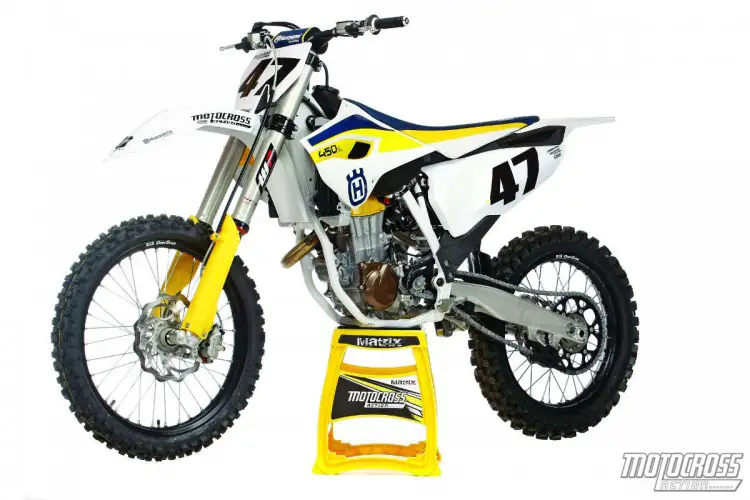
Q: HOW DOES THE 2015 FC450 RUN ON THE DYNO?
A: At 56.48 horsepower, the Husky FC450 has nothing to be ashamed of. Of course, it’s problem isn’t horsepower, but the feel of the horses. It isn’t as responsive as the other five 450s. On the plus side, even when clogged up, the Husky makes more peak power than the Honda, Suzuki or Kawasaki, but less than the 2015 Yamaha YZ450F’s 56.92 horsepower.
Q: WHAT CHANGES DID THE MXA WRECKING CREW MAKE TO THE 2015 HUSQVARNA FC450?
A: Here is a list of things that we changed.
Seat cover. Unless you like holding on for dear life every time you turn the throttle wide open, you will need to get an aftermarket seat cover. Don’t leave the showroom without it, because if you do, you just might leave the FC450 via the rear exit under acceleration.
Airbox cover. We Swiss-cheesed it.
Preload ring. When we eventually have the shock oil changed, we will install a metal preload ring.
Shift lever. We placed the Husqvarna shift lever in a bench press and bowed the middle of the shift lever to raise the tip.
Air-filter cage. Never install the air filter without double-checking to make sure that the back side is sealed.
Steering-stem nut. We run a Works Connection nut because it has a hole in the center that allows the gas-cap vent hose to spin freely.
Rear sprocket bolts. Never ride your Husqvarna or KTM without checking the rear sprocket bolts.
Spokes. Always check the spoke next to the rear rim lock; there is a 50/50 chance that it will be loose.
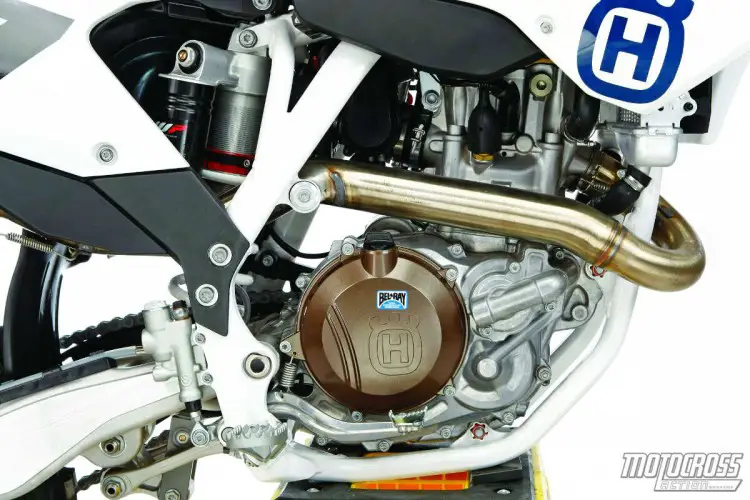
Q: WHAT DID WE HATE?
A: The hate list:
(1) All the things above. We don’t hate them with a passion, but we hate them enough to change them.
(2) Plastic bulge. Unlike a typical subframe, Husky’s plastic subframe bolts to the frame with two bolts at the bottom. Some test riders complained about this part of the plastic hitting their boot.
(3) Fork guards. We loved the old wraparound fork guards. They were a hassle to remove, but they protected the back of the fork legs from rock dings. The new fork guards look cool but aren’t as functional.
(4) Rear fender. Do not, under any circumstances, pick the Husqvarna FC450 up by its rear fender. It will break if you do. Use the built-in handholds.
Q: WHAT DID WE LIKE?
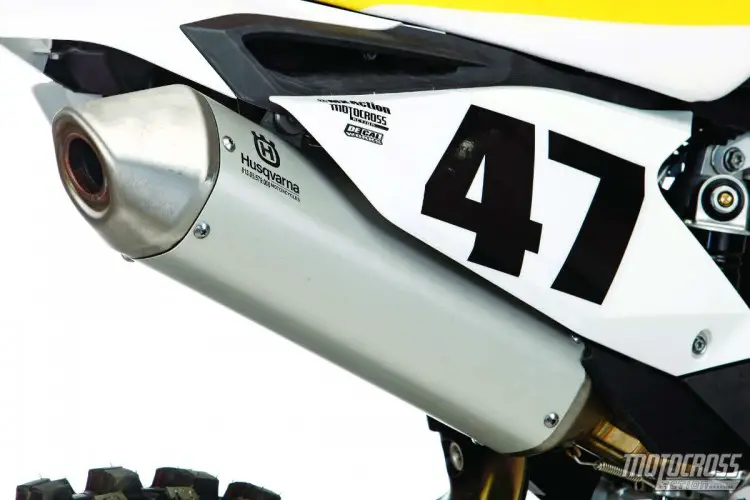
A: The like list:
(1) Tires. The FC450 is spec’ed with Dunlop’s new MX52 tire combo. Even though MXA typically runs Dunlop MX32s on intermediate terrain, the hard-pack MX52 is a good OEM tire choice.
(2) 4CS forks. Okay, they aren’t the greatest forks on the track in 2015, but after a decade with the old fork, we have hope for the future.
(3) Fork adjusters. No need for a screwdriver or to kneel in the dirt to adjust the damping. The clickers are right in front of you.
(4) Electric starting. Kick no more.
(5) Hydraulic clutch. This is the longest-lasting clutch in motocross.
(6) Brakes. Honda and Kawasaki tried to close the gap by going bigger in 2015, but the KTM/Husky Brembo combination is still the best.
(7) Shifting. The best-shifting transmission in motocross. No missed shifts. No false neutrals. No mystery shifts, and no refusing to budge at high rpm.
(8) Cosmetics. Thanks to in-mold graphics and a Swedish color scheme (even though this bike hasn’t been built in Sweden in decades), it is tastefully clean-looking.
(9) Rear axle. For 2015, the KTM gets a 25mm rear axle. Last year it had the small rear axle that KTM dropped in 2013.

Q: WHAT DO WE REALLY THINK?
A: We doubt that anyone is going to walk into a Husqvarna dealership and plunk down $9149 without already knowing that the Husky FC450 is really just a KTM 450SXF. And, because of a few miscues by Husqvarna, the KTM is more race-ready than the FC450. But, when a rider understands the differences and buys the Husky, that makes him special. He has two virtually identical choices, and his choice is to take the road less traveled. Maybe he prefers white to orange. Maybe he is an old-school racer from the Kent Howerton days. Maybe he wants to reward the revival of a grand old marque. Maybe, just maybe, Husqvarna offers a package that suits him better than the KTM, Yamaha, Honda, Kawasaki or Suzuki.
MXA HUSQVARNA FC450 SETUP SPECS
This is how we set up our 2015 Husqvarna FC450 for racing. We offer it as a guide to help you find your own sweet spot.
4CS FORK SETTINGS
If you never owned a KTM or Husky during their WP bladder fork days, you probably won’t be as impressed by the 4CS forks as the loyal Tifosi who feel that a weight has been lifted from the front of their bikes. The 4CS fork doe offer better damping, a plusher feel and easier adjustment; it is, however, not the answer to the WP fork problems. Yes, the 4CS forks are more progressive, and they don’t blow through their stroke. But, by the same token, they are a too firm in stock trim. Getting better, but still being the worst is not the kind of progress we are looking for. The Band-Aid fix is to lower the oil height (until they start bottoming), but the real fix is to send them out to your favorite fork guru.
For hardcore racing, we recommend this fork setup on the 2015 Husqvarna FC450 (stock specs are in parentheses):
Spring rate: 0.48 Nm
Oil height: 95mm (100mm)
Compression: 17 clicks out (15 clicks out)
Rebound: 17 clicks out (15 clicks out)
Fork-leg height: 5mm up
Notes: For the first time in long time, our AMA National test riders did not want the suspension stiffer than the Vet and Novice test riders. The 4CS forks were stiff enough. In fact, they wanted to be softer.
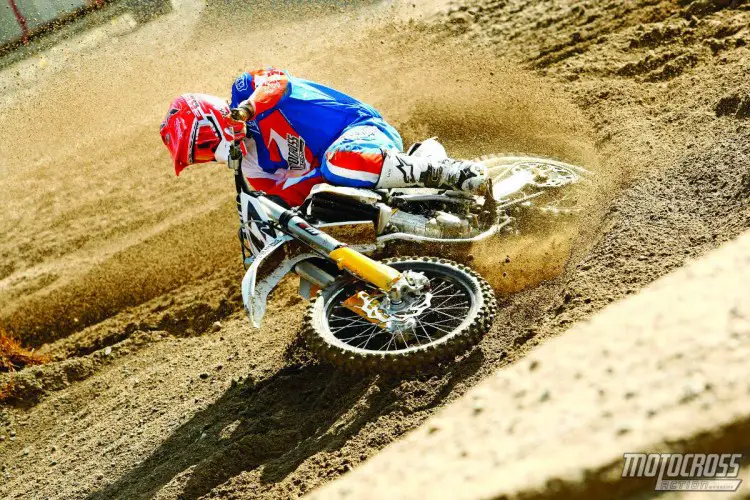
WP SHOCK SETTINGS
The rear suspension on the Husqvarna FC450 is totally new for 2015. The shock is 4mm longer. The link arm is 2.5mm longer, and the rising rate is more progressive in the first part of the stroke and less progressive at the end of the travel. All of this adds up to less wallow and a plusher feel. Most MXA test riders complained about a tendency to G-out under heavy loads, but were able to use the high-speed compression adjuster to iron this out—although not all the way out.
For hardcore racing, we recommend this shock setup for the 2015 Husqvarna FC450 (stock specs are in parentheses):
Spring rate: 5.7 Nm
Race sag: 100mm
Hi-compression: 1-3/4 turns out (2 turns out)
Lo-compression: 15 clicks out
Rebound: 10 clicks out (15 clicks out)
Notes: Heavier and faster riders needed a stiffer shock spring to help with the G-out issues. Most Vet riders can handle it by going in on the high-speed compression. We kept the compression clicker in the stock position but slowed the rebound damping way down.


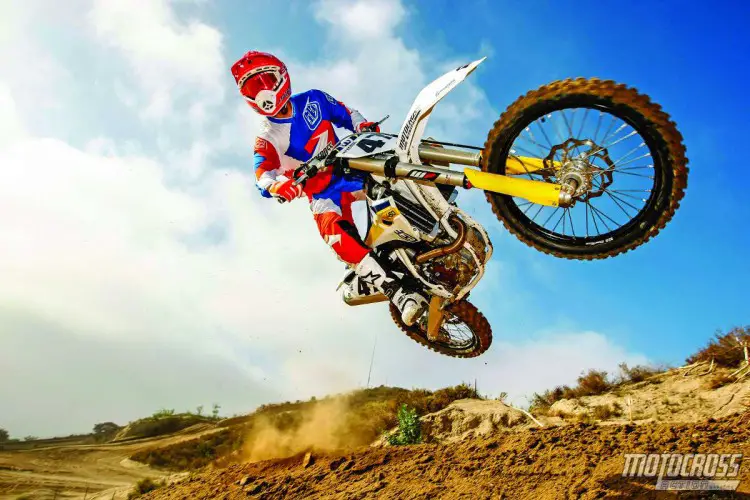
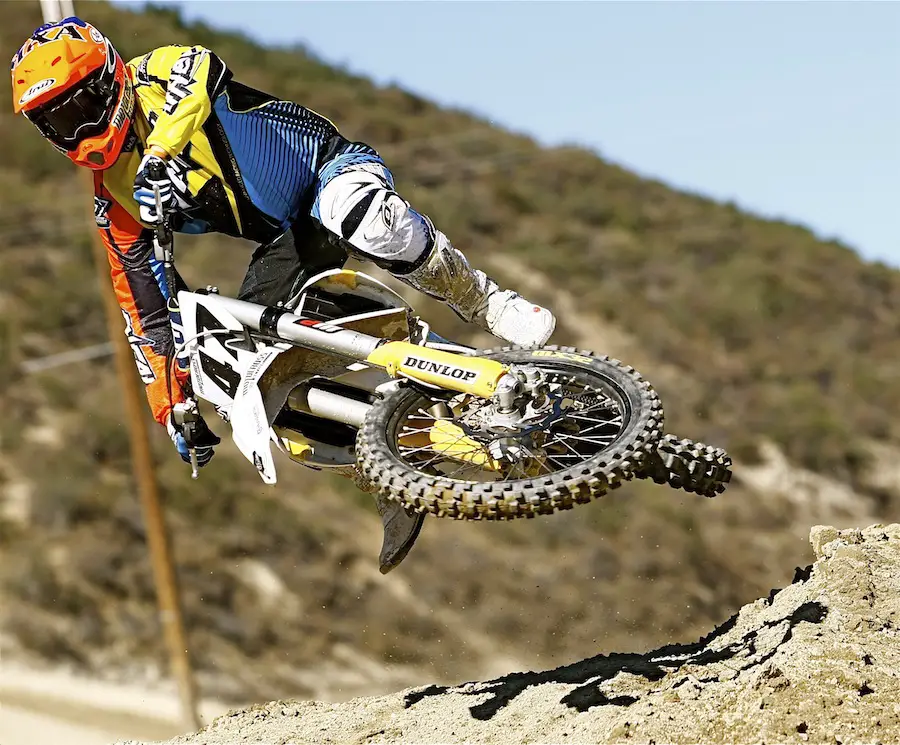


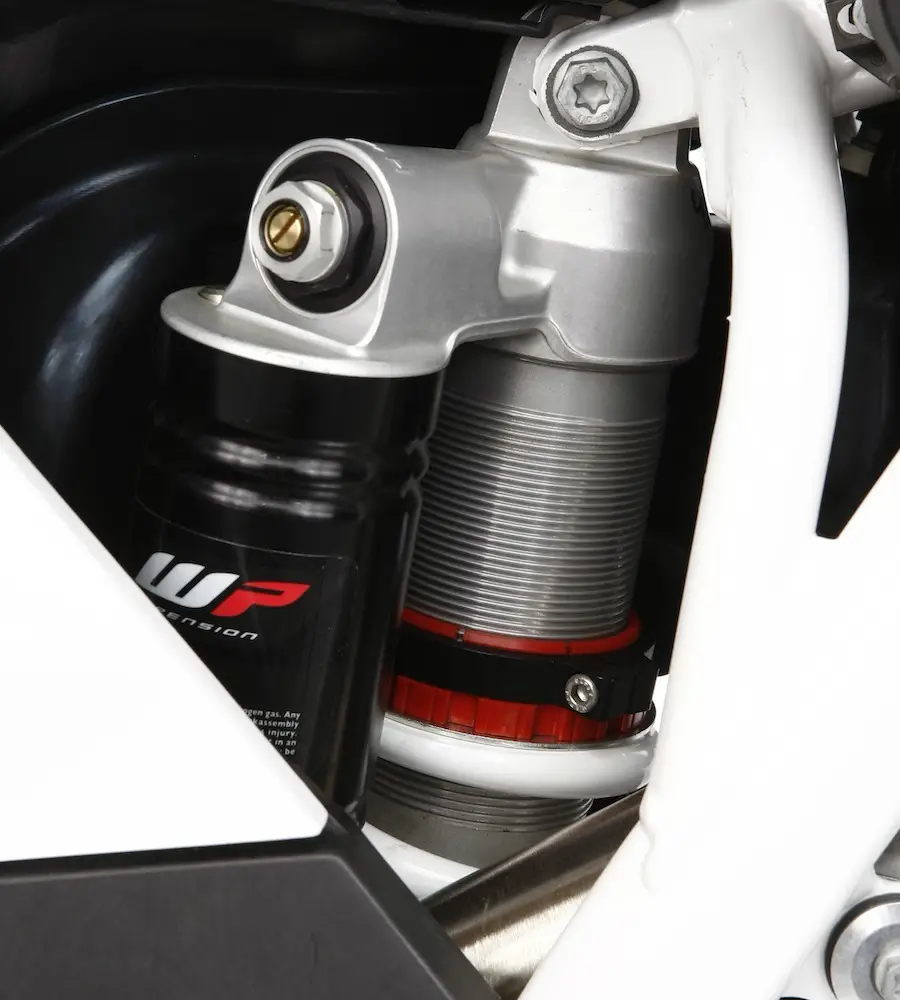



Comments are closed.